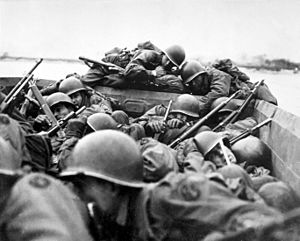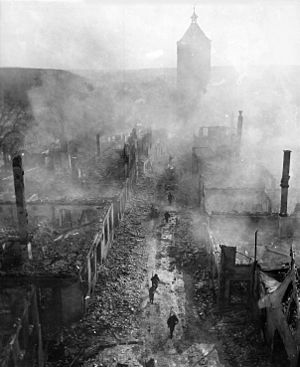Western Front (World War II) facts for kids
Quick facts for kids Western Front |
|||||||||
|---|---|---|---|---|---|---|---|---|---|
| Part of the European theatre of World War II | |||||||||
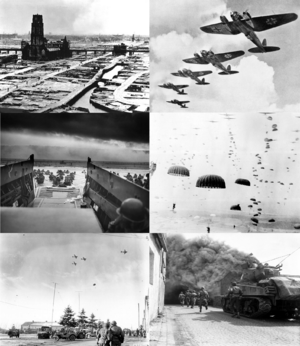 Clockwise from top left: Rotterdam after the Blitz, German Heinkel He 111 planes during the Battle of Britain, Allied paratroopers during Operation Market Garden, American troops running through Wernberg, Germany, Siege of Bastogne, American troops landing at Omaha Beach during Operation Overlord |
|||||||||
|
|||||||||
| Belligerents | |||||||||
|
Allies |
Axis |
||||||||
| Commanders and leaders | |||||||||
| 1939–1940 1944–1945 |
1939–1940 1944–1945 |
||||||||
| Strength | |||||||||
|
1939–1940
1944–1945
|
1939–1940
1944–1945
|
||||||||
| Casualties and losses | |||||||||
|
1940
1944–1945
(~70% of Allied troops and casualties were Americans)
Total:
|
1940
1944–1945
Total:
|
||||||||
| Civilian casualties: 1,650,000 dead |
|||||||||
The Western Front was a major area of fighting during World War II in Europe. It included countries like Denmark, Norway, Luxembourg, Belgium, the Netherlands, the United Kingdom, France, and Germany. The fighting here happened in two main parts.
First, from 1939 to 1940, Germany quickly took over many countries in Western Europe. This included Luxembourg, the Netherlands, Belgium, and France. After this, there was a big air battle between Germany and Britain called the Battle of Britain.
The second part of the Western Front began in June 1944. This is when the Allied forces landed in France. They fought their way through Germany until the war ended in May 1945.
Contents
Early Years of the War: Axis Victories (1939–1940)
World War II started on September 1, 1939, when Germany invaded Poland. Because of this, Britain and France declared war on Germany two days later. The first few months of the war were very quiet on the Western Front. This quiet period was known as the Phoney War.
The Phoney War: A Quiet Start
The Phoney War was a strange time at the beginning of World War II. Even though major European countries had declared war, there wasn't much fighting on the ground. It was a period of waiting and preparing.
French forces tried a small attack against Germany in the Saarland area. But they quickly stopped and went back. While most German soldiers were fighting in Poland, a smaller group guarded their strong defense line, the Siegfried Line. French troops faced them from their own defense line, the Maginot Line. British and French soldiers also set up defenses along the Belgian border.
There were only small fights during this time. The British Royal Air Force dropped propaganda leaflets over Germany. The first Canadian troops arrived in Britain. Western Europe stayed strangely calm for seven months.
Britain and France quickly started buying many weapons from the United States. This helped them get ready for the war. Germany tried to stop these supplies from crossing the Atlantic Ocean. This led to battles at sea, known as the Battle of the Atlantic.
Germany Invades Denmark and Norway
In April 1940, while the Western Front was still quiet, Germany launched Operation Weserübung. This was their invasion of Denmark and Norway. Germany acted before the Allies could make their own plans. The Allies had wanted to land troops in Norway to cut off Germany's supplies from Sweden.
The Germans successfully pushed back the Allies and defeated Norway's army. However, the German navy, called the Kriegsmarine, lost many ships during the two months of fighting.
Battles for Western Europe: Luxembourg, Netherlands, Belgium, and France
In May 1940, Germany launched a massive attack on France. This attack quickly overwhelmed the Allied forces, especially the French, Belgian, and British armies. Germany used a new tactic called "blitzkrieg" (lightning war). This involved fast, powerful attacks that broke through enemy lines.
Luxembourg fell in just one day. The Belgian and Dutch armies surrendered after a few days of intense fighting. Many British and some French soldiers were trapped in Flanders. They managed to escape from Dunkirk by sea. This escape was possible because of bad weather, German mistakes, and many British civilian boats helping out.
After Dunkirk, Germany continued its attack on France. Most of the French armies were defeated or captured. German forces quickly broke through French defenses and took Paris on June 14. As France was falling, Italy also declared war on Britain and France.
On June 22, 1940, France signed an agreement with Germany. Northern France was occupied by Germany. A new French government, called Vichy France, was set up in the south. This government was allowed to keep its colonies and navy.
In just six weeks, the Allied armies lost many soldiers. More than 375,000 were killed or wounded. About 1.8 million soldiers became prisoners of war. Germany had far fewer losses. This quick victory made German morale very high.
With France defeated, Germany thought about invading Britain. But the German navy had lost many ships in Norway. To invade Britain, Germany's air force, the Luftwaffe, needed to control the skies first.
A Quiet Period: 1941–1944
The German air force could not defeat the British Royal Air Force in the Battle of Britain. So, an invasion of Great Britain was no longer possible. While most of the German army prepared to invade the Soviet Union, Germany started building the Atlantic Wall. This was a series of strong defenses along the French coast. They expected an Allied invasion there.

Because invading across the English Channel was so difficult, the Allies decided to practice. On August 19, 1942, they launched the Dieppe Raid on Dieppe, France. Most of the troops were Canadian. The raid was a disaster, with almost two-thirds of the attackers becoming casualties. However, the Allies learned important lessons from this failure. These lessons would be very useful for future invasions.
For almost two years, there was no major land fighting on the Western Front. Only small commando raids and resistance actions happened. But the Allies launched a huge bombing campaign against Germany. American planes bombed during the day, and British planes bombed at night. Most Allied armies were fighting in the Mediterranean region.
By the summer of 1944, German commanders knew an Allied invasion was coming. German troops in France were organized under a command called OB West. This command controlled three main groups of armies.
Germany had to spread out its mobile reserves, including its tank divisions. This was because they didn't know where the Allies would invade. Each army group had its own mobile reserves.
The Second Front: 1944–1945
Allied Landing in Normandy: D-Day
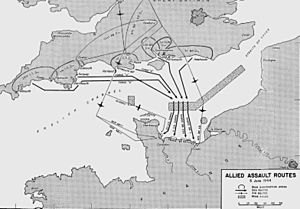
On June 6, 1944, the Allies launched Operation Overlord, also known as "D-Day". This was the long-awaited invasion to free France. The Allies had tricked the Germans into thinking the invasion would happen somewhere else. The real target was Normandy.
After two months of tough fighting, the Americans broke out of the Normandy area. Soon, the Allies were moving quickly across France. They trapped about 200,000 German soldiers in the Falaise Pocket. Just like on the Eastern Front, Hitler refused to let his troops retreat until it was too late. About 150,000 Germans escaped, but they left behind most of their valuable equipment. About 50,000 Germans were killed or captured.
The Allies had argued about how to advance. Some wanted a wide attack, others a narrow one. The American forces pushed south and east, spreading out into a wide front. This was the plan favored by the main Allied commander, General Dwight D. Eisenhower.
Freeing France: A Nation Liberated
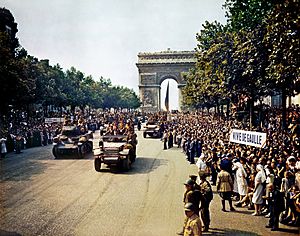
On August 15, the Allies launched Operation Dragoon. This was an invasion of Southern France. American and French armies quickly secured their landing area. They freed Southern France in two weeks. Then they moved north. Their advance slowed when they met strong German resistance in the Vosges Mountains.
By mid-September, three powerful Allied army groups were pushing the Germans in France. In the north, the British 21st Army Group was led by Field Marshal Bernard Montgomery. In the center, the American 12th Army Group was led by General Omar Bradley. In the south, the US 6th Army Group was led by Lieutenant General Jacob L. Devers. All three groups were under General Eisenhower's command.
The German army fell back under the Allied attacks. On August 19, the French Resistance started a general uprising. Paris was freed on August 25. The German general in Paris surrendered, ignoring Hitler's orders to destroy the city.
Freeing Northern France and the Benelux countries was very important. It stopped Germany from launching its V-1 and V-2 rockets at London and southeast England.
As the Allies advanced, their supply lines became very long. It was hard to get enough supplies from the Normandy ports to the front lines. By September, the front was close to the German border.
Allied Advance: From Paris to the Rhine River
Fighting on the Western Front became stable for a while. The Allied advance slowed down at the Siegfried Line, Germany's western defenses. In early September, American forces began a difficult fight through the Hurtgen Forest to break through this line.
The important port of Antwerp was freed on September 4 by the British. But it was at the end of a long river estuary. So, it couldn't be used until German positions along the river were cleared. This took a long and difficult campaign. Clearing the Scheldt Estuary was a big victory. It allowed supplies to be delivered much closer to the front lines.
In October, the Americans decided to capture the German city of Aachen. Hitler ordered the city to be held at all costs. In the battle, the city was taken, but both sides suffered many casualties.
South of the Ardennes, American forces fought from September to December. They pushed the Germans out of Lorraine and behind the Siegfried Line. Crossing the Moselle River and capturing the fortress of Metz was very hard. The Allies faced German reinforcements, supply shortages, and bad weather.
In November, the German front finally broke. The Allies advanced quickly, freeing Belfort, Mulhouse, and Strasbourg. They reached the Rhine River. However, the Germans still held a large area on the west bank of the Rhine, called the Colmar Pocket.
Operation Market Garden: A Bold Plan
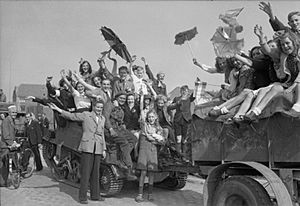
Field Marshal Sir Bernard Montgomery convinced the Allied commanders to try a daring attack. This was Operation Market Garden. He hoped it would get the Allies across the Rhine River quickly.
The plan was for airborne troops to fly from Britain and capture key bridges in the Netherlands. These bridges were in Eindhoven, Nijmegen, and Arnhem. British ground troops would then push through German lines to link up with the airborne forces. If successful, the Allies could advance into Germany without major obstacles.
The ground troops reached most of the bridges. But they could not link up with the airborne troops at the bridge over the Rhine in Arnhem. This led to the near destruction of the British 1st Airborne Division. The battle ended with Arnhem still in German hands. The Allies held a long, narrow bulge of land.
Winter Counter-Attacks: The Battle of the Bulge
Germany had been planning a huge counter-attack in the West. The plan was to attack through the Ardennes forest. They wanted to split the American and British armies and reach Antwerp. This attack began on December 16 and became known as the Battle of the Bulge.
American troops were defending the Ardennes. The Germans had early success because of bad weather, which hid their planes from Allied air forces. They pushed over 50 miles into Allied lines. But the Allies regrouped. A combined air and ground counter-attack stopped the Germans. By January 25, 1945, the Germans were pushed back to where they started.
Germany launched a second, smaller attack in Alsace on January 1, 1945. This was called Nordwind. They aimed to recapture Strasbourg. Allied lines were stretched thin from the Battle of the Bulge. Holding back this attack was costly and lasted almost four weeks. Allied counter-attacks eventually restored the front line to the German border.
Invading Germany: The Final Push
In January 1945, the Allies cleared a German position over the Roer river. Then, the Canadian and American armies launched a pincer movement. The Canadians advanced from the Netherlands, and the Americans crossed the Roer. The American crossing was delayed when the Germans flooded the Roer valley.
By the time the Americans crossed on February 23, other Allied forces were also close to the Rhine. German divisions on the west bank of the Rhine were largely destroyed. About 280,000 German soldiers were captured. By late March, the Western Allies had captured 1.3 million German soldiers in Western Europe.
The Allies crossed the Rhine River at four main points:
- American forces quickly used the Ludendorff bridge at Remagen. The Germans failed to blow it up.
- General Patton's American Third Army crossed the river south of Mainz on March 22.
- In the north, the British 21st Army Group crossed the Rhine at Rees and Wesel on March 23. This included the largest airborne operation in history, Operation Varsity.
- The US Seventh Army crossed the Rhine between Mannheim and Worms on March 26.
Once across the Rhine, the British moved northeast towards Hamburg and then towards Denmark. They captured Bremen on April 26. British and Canadian paratroopers reached the Baltic city of Wismar just before Soviet forces on May 2.
The American armies also spread out. The First Army helped encircle German forces in the Ruhr Pocket. On April 4, this encirclement was complete. About 300,000 German soldiers were captured. The American armies then pushed east to the Elbe River. They met Soviet forces near the Elbe in late April.
The US Third Army moved east into western Czechoslovakia and southeast into Austria. By the end of the war in Europe, the US 12th Army Group had over 1.3 million soldiers.
The End of the War in Europe

General Eisenhower's armies faced different levels of resistance as they moved towards Berlin. Some German forces fought fiercely, others barely resisted. British Prime Minister Winston Churchill wanted Eisenhower to push for Berlin. But Eisenhower decided it was not worth the potential casualties. He knew eastern Germany would be occupied by the Red Army (Soviet forces) anyway.
The US 6th Army Group moved southwest through Bavaria and into Austria. The Black Forest and Baden regions were taken by the French First Army. German forces put up strong fights in cities like Heilbronn, Nuremberg, and Munich in April. But they were eventually defeated.
Elements of the US 3rd Infantry Division were the first Allied troops to reach Berchtesgaden, Hitler's mountain retreat. The French 2nd Armoured Division captured the Berghof (Hitler's Alpine residence) on May 4, 1945.
On May 4, 1945, Field Marshal Montgomery accepted the surrender of all German forces in the Netherlands, northwest Germany, and Denmark. This happened on Lüneburg Heath.
On May 7, at his headquarters in Rheims, France, General Eisenhower accepted the unconditional surrender of all German forces. This was signed by General Alfred Jodl, the German Chief-of-Staff. Operations officially stopped at 11:01 PM Central European time on May 8. On that same day, Field Marshal Wilhelm Keitel signed another surrender document in Karlshorst, Germany. This officially marked the end of the war in Europe.
Images for kids
-
The pebble beach at Dieppe after the raid on August 19, 1942. A scout car was left behind.
-
Field Marshal Erwin Rommel visiting the Atlantic Wall defenses near the Belgian port of Ostend.
-
Routes taken by the D-Day invasion.
-
Crowds of French people line the Champs Élysées after the Liberation of Paris, August 26, 1944.
-
Dutch civilians celebrate the liberation of Eindhoven.
-
American soldiers taking up defensive positions in the Ardennes during the Battle of the Bulge.
-
US soldiers cross the Rhine river in assault boats.
-
People gathered in Whitehall to hear Winston Churchill's victory speech and celebrate Victory in Europe, May 8, 1945.
See also
 In Spanish: Frente occidental (Segunda Guerra Mundial) para niños
In Spanish: Frente occidental (Segunda Guerra Mundial) para niños




